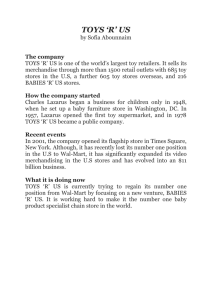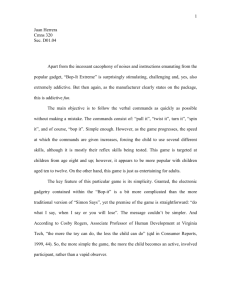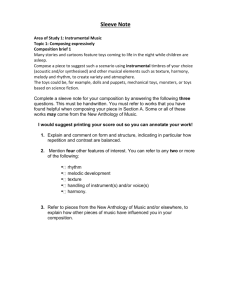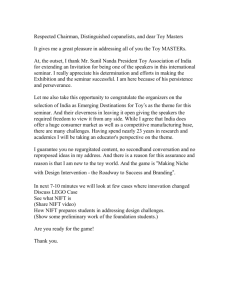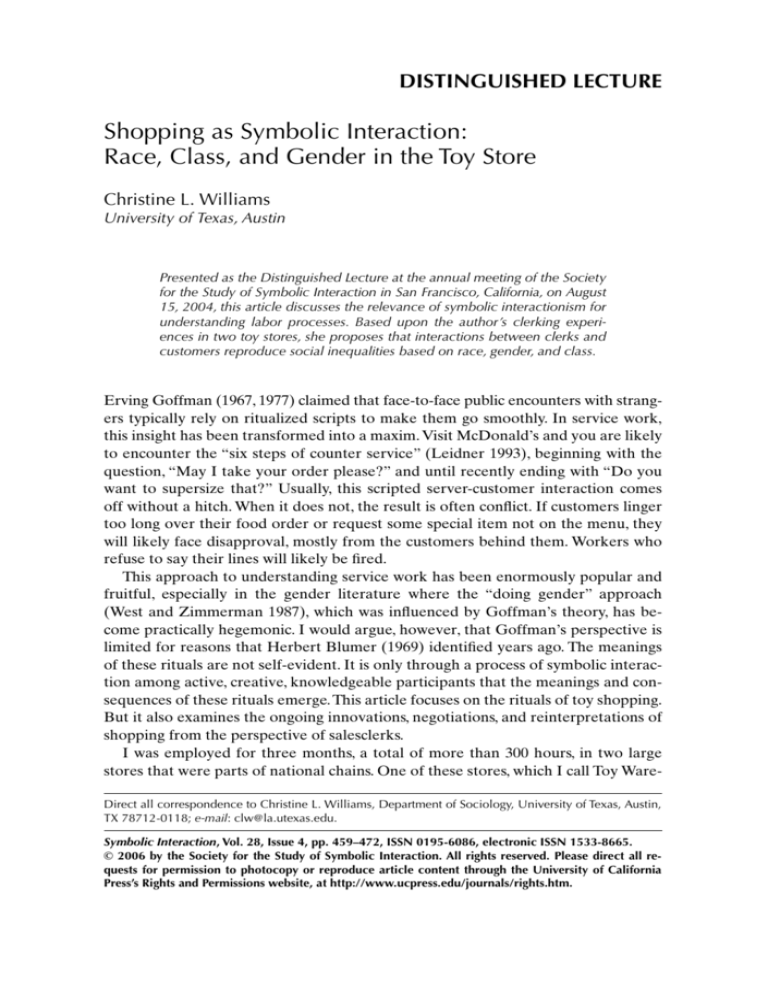
DISTINGUISHED LECTURE
Shopping as Symbolic Interaction:
Race, Class, and Gender in the Toy Store
Christine L. Williams
University of Texas, Austin
Presented as the Distinguished Lecture at the annual meeting of the Society
for the Study of Symbolic Interaction in San Francisco, California, on August
15, 2004, this article discusses the relevance of symbolic interactionism for
understanding labor processes. Based upon the author’s clerking experiences in two toy stores, she proposes that interactions between clerks and
customers reproduce social inequalities based on race, gender, and class.
Erving Goffman (1967, 1977) claimed that face-to-face public encounters with strangers typically rely on ritualized scripts to make them go smoothly. In service work,
this insight has been transformed into a maxim. Visit McDonald’s and you are likely
to encounter the “six steps of counter service” (Leidner 1993), beginning with the
question, “May I take your order please?” and until recently ending with “Do you
want to supersize that?” Usually, this scripted server-customer interaction comes
off without a hitch. When it does not, the result is often conflict. If customers linger
too long over their food order or request some special item not on the menu, they
will likely face disapproval, mostly from the customers behind them. Workers who
refuse to say their lines will likely be fired.
This approach to understanding service work has been enormously popular and
fruitful, especially in the gender literature where the “doing gender” approach
(West and Zimmerman 1987), which was influenced by Goffman’s theory, has become practically hegemonic. I would argue, however, that Goffman’s perspective is
limited for reasons that Herbert Blumer (1969) identified years ago. The meanings
of these rituals are not self-evident. It is only through a process of symbolic interaction among active, creative, knowledgeable participants that the meanings and consequences of these rituals emerge. This article focuses on the rituals of toy shopping.
But it also examines the ongoing innovations, negotiations, and reinterpretations of
shopping from the perspective of salesclerks.
I was employed for three months, a total of more than 300 hours, in two large
stores that were parts of national chains. One of these stores, which I call Toy WareDirect all correspondence to Christine L. Williams, Department of Sociology, University of Texas, Austin,
TX 78712-0118; e-mail: clw@la.utexas.edu.
Symbolic Interaction, Vol. 28, Issue 4, pp. 459–472, ISSN 0195-6086, electronic ISSN 1533-8665.
© 2006 by the Society for the Study of Symbolic Interaction. All rights reserved. Please direct all requests for permission to photocopy or reproduce article content through the University of California
Press’s Rights and Permissions website, at http://www.ucpress.edu/journals/rights.htm.
460
Symbolic Interaction
Volume 28, Number 4, 2005
house (all store names have been changed for this article), was a “big box” toy store
located in a low-income redevelopment zone. I was one of four white women who
worked on the staff of about seventy; most of my coworkers were African American women and men. The other store, which I call Diamond Toys, was in an urban,
upscale shopping district that catered to high-income shoppers and tourists. At that
store, most of the workers were white; only three African Americans (all women)
worked on the staff of about seventy. Latina/os and Asian Americans also worked
at these stores, making up about 20 percent of the workforce. This article examines
interactions between clerks and customers and discusses the relevance of symbolic
interactionism for understanding labor processes.
The article first describes the “rules” governing salesclerks in their interactions
with customers at the two toy stores. These “official” rules are formulated by the
corporations that own the toy store chains. Second, the article discusses the “ropes,”
the informal rules that employees devise and follow to ensure order and preserve
their self-respect in their interactions with customers. I argue that both the “rules”
and the “ropes” take into account the race, gender, and class characteristics of the
clerk and the customer. Finally, the article discusses what happens when these formal and informal rules are not followed and interactions break down into conflict.
Whether an interaction can be repaired depends on race, class, and gender: because
different groups have different resources to draw on to assert their will in the toy
store, the resolution of any particular conflict is shaped by social inequality and the
creative efforts of the individuals involved.
THE RULES: CORPORATE CULTURE IN TOY STORES
Today, nearly every large store in a specialty area offers the same goods. Because of
this, corporations attempt to develop specific “themes” to distinguish themselves
from their competitors (Michman and Mazze 2001). Their goal is to entertain as they
sell. Thus, toy stores, like other specialty stores, now sell a “mood” in addition to
Barbies and Big Wheels.
The corporation that owned the Toy Warehouse wanted its stores to create a fun,
family-oriented atmosphere. Sales workers were expected to demonstrate a high
degree of spirited enthusiasm. We were required to hand out balloons and stickers
to children and sing to them on their birthdays. The name badge I wore proclaimed
that I had been “delighting guests since 2001.” Like all new employees, I was required
on my first morning shift to hula-hoop in front of the staff. All clerks were required
to form a gauntlet around the front door when the store opened and applaud the
customers as they entered the store, much to their bewilderment.
In giant retail stores, corporate culture is usually communicated to new hires through
perfunctory training sessions that last no more than one day. At the Toy Warehouse, our
training consisted of watching nine 20-minute videotapes on everything from handling returns to selling the new Game Boy. One videotape showed executives, on
stage at a corporate event, leading store directors in group singing and rousing cheers.
Shopping as Symbolic Interaction
461
Whereas the Toy Warehouse aspired to present an image as an exciting playground for children and their families, Diamond Toys portrayed itself as a high-end
specialty store oriented toward meeting the needs of discriminating adult shoppers.
The store aimed to flatter the sophisticated tastes of the elite or those who would
like to be elite. The very set-up of the store encouraged this aura. Diamond Toys resembled a fancy department store, not a warehouse. A door attendant out front
greeted customers. Inside were lavish displays of giant toys with mechanical moving
parts. A theme song played in a continuous loop, making me at times feel trapped
inside a ride at Disneyland. The store also seemed to have the theme park effect on
the many adults and children who stood in awe and marveled at the displays.
We did not have to watch videos during our training at Diamond Toys. Instead
we were issued an employee handbook. The personnel manager, Leslie, took the
three new hires to a seminar room and read the entire 30 page document to us. We
were invited to interrupt the presentation at any time to ask questions.
Much was said about the dress code. We were required to wear the company issued maroon polo shirt tucked into belted chino slacks or skirt. Belts had to be
black, tan, cordovan, or brown. No outside stitching or pockets were allowed, as
this conveyed the look of jeans, which were forbidden. Leslie showed us where the
ironing board and iron were kept “just in case” we needed them. We were allowed
only two earrings per ear and a single nose stud. No visible tattoos and no unconventional hair color were allowed.
The corporate instruction we received as salesclerks was summed up in the “Five
Is of Customer Service.” These were: initiate, inquire, inform, include, and into the
register. We were told we must initiate contact within thirty seconds with each customer who wandered into our section. The corporation offered some suggestions on
the best ways to do this: we might invite them to play with a toy, comment on some
article of their clothing (“That’s a great Bulls sweatshirt!”), or mention some little
known fact about the merchandise (“Did you realize that $99 stuffed animal is 100
percent washable?”). After a successful initiation, we were instructed to try to determine the customer’s needs with open-ended questions or remarks, such as: “Tell
me about the kind of party you are planning.” At the “inform” stage we were to match
the customer’s needs with product features (about which we never received instruction), and at the “include” stage we were to recommend accessories to complement
the main purchase (e.g., doll clothes to go with dolls). Our goal was to sell a minimum of two UPTs (units per transaction). We received a printout three times per
shift showing us how we were doing.
Thus, the corporate board of Diamond Toys imagined a sales staff of Jeeves-like
butlers. Correspondingly, their ideal customer was a member of the bourgeoisie in
need of professional consultation on his or her purchases. Oddly, this customer was
never shown in the instructional materials. There were no people in the toy catalogs,
either; the focus was always on the “special” merchandise we offered.
The Toy Warehouse, on the other hand, was quite explicit about what its ideal
customer looks like: she was a middle-class white mother. Several of the videos fea-
462
Symbolic Interaction
Volume 28, Number 4, 2005
tured this woman and demonstrated the ways we were supposed to serve her. She
usually knew what she wanted (a Game Boy, for instance), but she might need to be
told that it required game cartridges, batteries, and a light worm. She did not like to
be kept waiting, so we were supposed to work quickly to accommodate her (no lingering over party decorations). My manager, Olive, urged me to treat every woman
in the store as if she were my mother. Mothers made the purchasing decisions, she
said, so they got the special treatment. Olive said that the average child has $20,000
spent on toys for them before they are eighteen, and the Toy Warehouse wanted to
be the place where most of that money was spent.
Advertising displayed in the Toy Warehouse were directed to middle-class families.
The store “sponsored” National Day for Children, for example. This was celebrated
by posting signs that read “National Day for Children” and putting out a stack of
leaflets on a card table that gave “10 reasons to celebrate your child!” Also offered
were a college savings plan (which put a small percentage of any purchase in a special account for college tuition), a parenting newsletter, and a summer camp program
at which children could be dropped off for a two-hour activity on weekday mornings.
The “child” imagined by the Toy Warehouse’s corporate office was thus middleclass and college-bound, from a traditional family where the mother did not work
for pay but did all the shopping. Children were expected to have their own ideas
about what they want. The store sold “gift cards” to give to children for their birthdays and special occasions. The equivalent of gift certificates, these were little plastic cards that look like credit cards. They were packaged in greeting card envelopes
with a space to write in the child’s name and the dollar amount of the gift. At Diamond Toys, in contrast, children were much less central to the marketing agenda.
Although they were the intended consumers of most of the merchandise, they were
treated more as pampered and coddled pets than as willing and engaged buyers. At
Diamond Toys, adults were our primary focus; it was to them that we directed our
expert knowledge and solicitous attention. Leslie told us that people came to our
store and were willing to pay more because we were “the ultimate toy experts.” (In
contrast, the Toy Warehouse considered kids to be the ultimate toy experts.) At
Diamond Toys, we did not strive to make the shopping experience fun for families;
rather, the mood we aspired to set was one of careful and quiet deliberation to
assist adults in making a suitable purchase.
How did these corporate expectations play out in practice? In the most obvious
sense, they selected for different kinds of customers. Shoppers at the Toy Warehouse represented all levels of the stratification system. I would often marvel at
how our “guests” (as we were required to call them) were from every racial/ethnic
group and every social class. Rich women with huge diamond rings shopped next to
very poor families who were shabbily dressed. Recent immigrants from Africa, India,
and Central America were also there, some in traditional clothes. Diamond Toys attracted a more upper-class clientele. It was like a gated community for rich whites.
Although the doors opened onto diverse and chaotic urban streets, only the wealthy
or the tourist class entered.
Shopping as Symbolic Interaction
463
But what impact did the corporate rules have on actual interactions between
clerks and customers? Retail workers were expected to conform to the corporate
culture, but they often developed their own rules for dealing with customers that
sometimes clashed with that agenda. I call those rules “the ropes.”
THE “ROPES”: SHOP FLOOR CULTURE
New hires learned the ropes from observing experienced workers on the shopping
floor. One of the first lessons I learned at the Toy Warehouse was that middle-class
white women shoppers got whatever they wanted. I suppose that as a middle-class
white woman myself, I should have felt empowered by this knowledge. Instead I
have come to understand this preferential treatment as a result of race and class
privilege.
Most of the customers at both stores were women. At the Toy Warehouse we
were told that women make 90 percent of the purchase decisions, so we were to
treat women deferentially. Olive told me that the store abides by the “$19,800 rule.”
If a customer wanted to return merchandise and it was questionable whether we
should take the return (because it had been broken or worn out by the customer, or
because the customer had lost the receipt), we should err on the side of the customer. The company was willing to take a $200 loss because doing so might please
the customer so much that she would return to the store and spend the rest of the
$20,000 on each of her children.
But in my experience, only the white women got this kind of treatment. Not surprisingly, many developed a sense of entitlement and threw fits when they were not
accommodated. The following occurred at the Toy Warehouse.
A white woman in her fifties came into the store to pick up a bike that she had
ordered two days previously. She had paid for the bike to be assembled and
ready for her to pick up that day. She waited for almost a half hour as we scoured
the back room for the bike. We couldn’t find it. The woman was getting madder
and madder as she waited. There were some other bikes like it that were in boxes
and the bike guys offered to assemble one for her but that would have required
another wait, so she yelled, “To hell with it, give me my money back, and I will
never ever come to this store again!” She demanded to talk to the manager.
Olive tried to appease her by offering her a $25 gift certificate, but she refused
and yelled about how terrible we all are. After she left the store Olive called the
whole staff up to the service desk and chewed us out. Losing this customer was a
really big deal to Olive. (author’s field notes)
Middle-class white women had a reputation at the store of being overly demanding
and abusive. Susan, a thirty-five-year-old Latina, agreed with my observation that
rich white women were the most demanding customers; she said they always demanded to see the manager and they always got mollified. In contrast, African
American and Latina/o customers hardly ever complained. If they did complain,
she said, they would not get any satisfaction.
464
Symbolic Interaction
Volume 28, Number 4, 2005
Susan’s remarks illustrate some of the elaborate stereotypes that service desk
workers used in the course of their daily transactions. Immediate assumptions were
made about customers based on their race, gender, and apparent social class; workers
responded to customers using these cues. Middle-class white women were the most
privileged customers, so not surprisingly, many developed a sense of entitlement.
One of the most eye-opening examples of white women’s sense of entitlement that I
witnessed in the Toy Warehouse was their refusal to check their bags at the counter.
Stealing was a big problem in the store, so customers were required to leave all
large bags and backpacks at the service desk. A large sign indicating this policy was
posted on the store’s entrance. The vast majority of customers carrying bags immediately approached the desk to comply with the rule. The exception was white
women, who almost universally ignored the sign. When challenged, they would argue,
and we would have to insist so as not to appear to be unfair to the other people. I
guiltily recognized myself in their behavior. Since then, I always turn over my bag.
White women developed a sense of entitlement because in most instances they
got what they wanted. Members of other groups who wanted to return used merchandise, or who needed special consideration, rarely were accommodated. The
week before the bike incident, I was working at a cash register that broke down in
the middle of a credit card transaction. A middle-class black woman in her forties
was buying in-line skates for her ten-year-old daughter. The receipt came out of the
register but not the slip for her to sign, so I had to call a manager. Olive came over
and explained that the customer needed to go to another register and repeat the
transaction, but the customer refused because the sale seemed to go through all
right and she did not want to be charged twice. She had to wait over an hour to get
this situation resolved, and she was not offered any compensation. She did not yell
or make a scene; she acted stoically through the long wait for a resolution. I felt sorry
for her. I went over to the service desk to tell a couple of my fellow workers there
what was happening, and I said they should just give her the stuff and let her go. My
fellow workers thought that was the funniest thing they had ever heard. I asked,
“What about Olive’s $19,800 rule?” but they just laughed at me. Celeste said, “I want
Christine to be the manager, she just lets the customers have whatever they want!”
It has been well documented that African Americans suffer discrimination in
public places, including stores (Feagin and Sikes 1995). They report that they are
followed by security personnel, treated harshly by attendants, and flatly refused service. The flip side of this discrimination is the privilege experienced by middle-class
whites. This privilege is not recognized precisely because it is so customary. Whites
expect first-rate service; when it is not forthcoming, some feel victimized, even discriminated against. This was especially apparent in the Toy Warehouse, where most
of the sales people were black. I noticed that when white women customers were
subjected to long waits in line or if they received what they perceived as uncaring
attention, they would often sigh loudly, roll their eyes, and try to make eye contact
with other whites, looking for a sign of recognition that the service they were receiving was inferior and unfair.
Shopping as Symbolic Interaction
465
Just as white customers are treated with more respect, so are white service
workers, especially by white customers. At the Toy Warehouse, where I was one of
only four white women workers, I noticed that shoppers frequently assumed that I
was in charge.
This assumption was especially clear on one occasion at the Toy Warehouse
when I was being trained at the service desk. A group of three customers was in line
at one time as Tanesha, a twenty-three-year-old African American woman, was
training me. The first person in line was an Indian woman who returned an item and
was given her refund on a merchandise credit card. She already had a card from a
previous exchange and she wanted to combine the amounts of the two cards onto
one card. Tanesha tried to do this, but soon got all tangled up in the computer system and she had to call for help from Olive. This made the other customers (two
white women) in line very mad. After a few minutes, they elbowed up to the
counter and complained to me about the wait. I said something about being in
training, and they thought I meant that I was training Tanesha. So one of them said,
“Well, call up someone else to the register!” I said I would have to ask Tanesha to
do this. They demanded that I stop training Tanesha for a moment to call another
person to the exchange desk. I said, “No, you don’t understand, I’m the one who is
in training, she knows what she is doing and she is the only one who can call for
backup and she is in the middle of trying to accommodate this other customer.” I
think they were embarrassed by their presumption that the white woman was in
charge. When they realized their mistake they looked mortified and stepped back
from the counter.
In addition to assuming that I was in charge, customers at both stores frequently
assumed that I was an expert on childhood. This is not an altogether irrational assumption. I was working in a toy store, and I suppose that I looked like a mother
with personal experience of children’s toys. But I did not have children, and I knew
virtually nothing about toys or children’s popular culture before I took these jobs.
And I was not alone in this. It is important to realize that workers being paid $7.50
an hour do not necessarily have any expertise regarding the merchandise they are
selling. We received no training whatsoever. Any advice we gave we literally
made up.
At the Toy Warehouse, most customers did not expect elaborate advice from the
salesclerks. Anyone who has ever shopped in a big box store has probably observed
workers trying to avoid customers as if they were playing a game of hide-and-seek.
Customers have to make a special effort to find a clerk if they need advice. Crossing
the floor I would often look down to avoid eye contact with customers either because I was dealing with a previous request or I was trying to make it to the break
room for my fifteen-minute rest. Any time we spent interacting with a customer was
deducted from our break.
Sometimes worker resistance to customers at the Toy Warehouse was more blatant. In addition to avoidance, we would sometimes perform our role half-heartedly, tell
a customer we did not carry a particular toy (even if we did), or palm off a demanding
466
Symbolic Interaction
Volume 28, Number 4, 2005
customer on a new or especially eager employee. In the break room we constantly
made fun of customers’ stupidity and congratulated each other on our ability to control disgusting and hostile shoppers. We also made an art out of ignoring requests.
In contrast, avoiding or ignoring customers was taboo at Diamond Toys. Although
we complained about customers in the break room, we never expressed our disdain
publicly. At Diamond Toys, our job was to cater to customers. It was not unusual to
spend fifteen to twenty minutes assisting a single customer. Customers asked me
such questions as, “What are going to be the hot toys for one-year-olds this Christmas?” and “What one toy would you recommend for two sisters, aged five and nine?”
One mother asked me to help pick out a $58 quartz watch for her seven-year-old
son. A personal shopper phoned in and asked me to describe the three Britney
Spears dolls we carried, help her pick the “nicest” one, and then arrange to ship it to
her employer’s niece. Customers also asked detailed questions about how the toys
were meant to work, and they were especially curious about comparing the merits
of the various educational toys we offered (for example, I was asked to compare the
relative merits of the “Baby Mozart” and the “Baby Bach”).
I was amazed that at Diamond Toys, most customers did not mind waiting for
their turn to consult with me. When the lines were long they did not make rude
huffing noises or try to make eye contact with their fellow sufferers. The two stores
were staffed and structured quite differently, and that certainly helped to explain
some differences in the experiences (and satisfaction) of the customers. We were so
understaffed at the Toy Warehouse that it seemed as though we were running the
whole time we were at work. I could not help but think, however, that customers—
who were mostly white—cut us more slack at Diamond Toys because most of us
were white. We were presumed to be professional, caring, and knowledgeable even
when we were not. My African American coworkers at the Toy Warehouse, in contrast, were assumed to be incompetent and uncaring. Like the people who employed
domestic workers studied by Julia Wrigley (1995), white customers seemed less respectful of racial/ethnic minority service workers than of white workers; it seemed
that they were willing to pay more and wait longer for the services of whites because they assumed that whites were more refined and intelligent.
The culture of the stores also reflected these race and class dynamics. Diamond
Toys embodied whiteness both physically and symbolically; the Toy Warehouse embodied a more diverse, creative, and flamboyant style. This was reflected in our uniforms. The dress code was strictly enforced at Diamond Toys, much to the chagrin
of my younger coworkers, who especially hated the belted and tucked-in look.
Some tried to subvert it by wearing their pants low on their hips, but this was a
minor alteration. I personally thought the uniforms were hideous. I was completely
taken aback once when a customer complimented me on how I looked. I was on a
ladder retrieving a doll stroller from the valence, and a middle-aged white woman
looked up, smiling, and said, “Your uniforms look so nice and comfortable!”
The dress code at Diamond Toys was not unlike the one that many area school
districts had recently imposed on elementary and middle-school children, which
Shopping as Symbolic Interaction
467
probably explains my younger coworkers’ disdain for them. But why do customers
like them? Edward Morris (2005), who has written about school uniforms in minority schools, has argued that a “tucked in shirt” signifies whiteness, middle-class respectability, and a professional demeanor, especially for the middle-class teachers
who enforce the dress code. (To the kids, the uniforms evoked prison garb comparisons.) This analysis matches my experience at Diamond Toys, where our uniforms
seemed to reassure customers that we were professionals who knew what we were
talking about.
At the Toy Warehouse we wore bright orange vests over matching companyissued camp shirts, giving us the look of warehouse attendants. The bright colors
were intended, no doubt, to make us easy to spot on the floor. We were allowed to
wear black jeans to work. Most of the young men wore fashionable low riders that
hung below their underwear and dragged on the floor. The young women wore
super skin-tight hip huggers. Because it was summer, we were also given the option
to wear shorts. A coworker named Socorro told me that she was not planning to
take advantage of that because people did not need to see the tattoos on her calves.
Most of my other coworkers were only too eager to show off their art, as they called
it. The younger ones had multiple piercings, including tongue studs. Careful attention was also paid to hairstyles—the more outrageous and intricate the better. Most
men and women wore very elaborate and intricate hair designs incorporating dying,
shaving, sculpting, braiding, and extensions.
White customers at the Toy Warehouse seemed frequently unnerved by their interactions with the clerks in the store. I recall one time when a white woman customer stopped my coworker Gail to ask for a gift suggestion for a ten-year-old boy.
Gail, who was swiftly walking across the floor to deal with another customer’s request, practically shouted at her, “Don’t ask me about no boys; I got girls, not
sons!” and then she took off. The white woman looked startled at the response.
What she did not know was that Gail found a coworker who had sons to answer the
woman’s question. The caring, efficiency, and sense of humor of my coworkers at
the Toy Warehouse often went unnoticed by white customers.
Realizing that white customers in particular treated them with disrespect and
even disdain, my African American coworkers developed interactional skills to
minimize their involvement with them. I noticed at the service desk that the black
women who worked there did not smile or act concerned when customers came up
for complaints or returns. They did their work well and efficiently, but they did not
exude a sense that they really cared. Rather, they looked suspicious, or bored, or resigned, or even a little miffed. Over time I learned that this attitude of ennui or suspicion was cultivated as a way to garner respect for the work. It was saying, “This
isn’t my problem, it’s your problem, but I will see what can be done to fix it.” If
workers were more enthusiastic and it turned out the problem could not be fixed,
they would look incompetent, which was the assumption that too many white customers were willing to make of black women. So those workers made it appear that
the problem was insurmountable and when they did resolve it (which was most of
468
Symbolic Interaction
Volume 28, Number 4, 2005
the time), they garnered a little bit of respect. But it was at the cost of appearing
unfriendly, so the store received negative customer service evaluations.
With experience, I developed my own set of facial gestures and attitudes to manage customers. At the cash register, I learned to look cheerful, unless there was a
void and I had to wait for a manager to respond to a page, in which case I became
expressionless and looked off to the distance, like a computer in shut-down mode.
If I acted impatient, I learned, the customers would become impatient. At the service desk, where customers returned or exchanged merchandise, I learned to act
like a student. To get a refund, customers had to explain what the problem was. I
found that the best technique to do this work effectively was to bow my head a little, but raise my eyebrows and look into the eyes of the customer. No smiling and
no frowning. This made me look a little skeptical, but also subservient. It also
made me look stupid. I had to listen to the stories but not act as if I cared or was
interested and then efficiently process the request. If they requested something
that was against store policy, I just had to report that, without sounding apologetic
or giving the impression that the rule was wrong. “That’s just the rule, it’s store
policy, no exceptions.” If they argued, I would call a manager. This kind of affectless performance kept customers under control and less likely to be insulting or to
make a scene.
Manipulating customers through self-presentation constitutes an informal “feeling rule” (Hochschild 1983). These techniques for displaying affect were developed
by workers to manage and minimize difficult customer interactions. I call them informal rules because management would have preferred that we always conveyed
serious concern and solicitude, but workers at the Toy Warehouse knew that would
only spell trouble. Moreover, the informal rules were sensitive to race and gender
dynamics in a way that management rules could not be. The fact is that different
groups had to use different means to assert themselves and their interests, and the
stratification of the jobs at the store meant that we all had different levels of formal
and informal power to resolve situations. White men had the most institutionalized
power and authority in the stores. The store directors in both places where I worked
were white men who could and did trump any decision made by managers or sales
associates. Sales associates had severely limited options for resolving disputes,
owing in large part to surveillance mechanisms intended to keep us from stealing.
But maintaining control was also dependent on the race and gender of both
workers and customers.
INTERACTION BREAKDOWN: SOCIAL CONTROL IN THE TOY STORE
It may seem incongruous to talk about power and control in the context of toy
shopping. But customers frequently misbehave in stores. In addition to seeing customers throwing fits at the service desk, every day I witnessed customers ripping
open packages, hiding garbage, spilling soft drinks, and generally making a mess of
the store.
Shopping as Symbolic Interaction
469
As a middle-aged white woman, I could exercise some control over the extremes
of this bad behavior. I could stand nearby, for example, and the customers might
notice me and guiltily try to stuff the toy back into the box or replace the dozen toys
they had pulled off the shelf. We were not allowed to confront customers, even if
we suspected them of stealing or destroying the merchandise, but we were expected
to develop subtle ways to control them. I could not do this as well as my male coworkers could, but I was definitely more respected (and feared) than my women
coworkers who were African American, Asian American, and Latina.
One example of this involved two of my African American coworkers at the Toy
Warehouse. One night, the store had officially closed but I was still at my register. I
saw Selma, an African American woman in her late forties, and told her that there
were still people in the store shopping. She went to clear them out, saying, “We’re
closed, you must leave now, the registers are closing down!” I walked over to the
service desk to close out my register and I saw Selma and Doris, the night manager
(an African American woman in her fifties), escorting some white people out. Later
when I was being audited in the manager’s office, Selma came in very upset because
the woman she and Doris escorted out spat out her chewing gum at Selma. Doris
and Selma were appalled. Doris had said to them, “That is really disgusting, how
could you do that?” And the woman said to Doris, “What is your name?”—as if she
intended to report her. This angered Selma so much that she said, “If you take her
name, take mine too,” and showed her name tag. Selma told the woman that she
was never invited back to this store. Selma was very distressed. She knew she could
be fired for what she said. I sensed it was doubly humiliating to have to be concerned
that she would be punished for talking back to a white woman who spat at her.
I did not have too much trouble controlling white women. The customers that I
had the hardest time controlling were men. Men were outnumbered by women in
both stores. At the Toy Warehouse, I saw them mostly on the weekends, which seemed
to be the most popular time for fathers to come in with their children. At Diamond
Toys, I observed men tourists shopping with their families, businessmen buying small
gifts for their children back home, and during the Christmas season, men buying highend toys for their wives. In general men seemed to be annoyed to be in the stores,
and they sometimes acted annoyed with me, especially when unaccompanied by
women. One white man at the Toy Warehouse tossed his shopping list at me when I
was working at the service desk. He expected me to assemble the items for him or
to get someone else to do it. Some men were just mean. On two occasions, men demanded to use my telephone, against which there were strict rules. I said they were
not allowed to use it, and they just reached over the counter and did it anyway. I
was terrified that my manager would walk by and yell at me, maybe even fire me. On
another occasion at Diamond Toys, a business professor in town for a conference
was upset because a Barney sippy cup he wanted to buy was missing its price tag
and I could not find it listed in the store inventory. He made me call over the store director and subjected both of us to a critique of store operations, which he threatened
to submit for publication to a business journal unless we sold him the sippy cup.
470
Symbolic Interaction
Volume 28, Number 4, 2005
The sense of entitlement I observed in these men customers was different from
that which I observed in white women. Perhaps the expectation that shopping was
“women’s work” made these men feel entitled to make me to do their shopping for
them or reorganize the store to make it more convenient for them. To assert masculinity while engaging in this otherwise feminine activity seemed to require them to
disrupt the routinized clerk–customer relationship.
In an extreme manifestation of this shopping masculinity, on three occasions (all
at the Toy Warehouse), men threw things in my direction. Once a male customer
threw a toy that struck me on the head. The customer was a young African American, maybe thirty years old. When I first arrived at the service area he was trying to
get a cash refund for a toy, baby building blocks packaged in a plastic pail. Leticia, a
twenty-three-year-old Latina, told him that he would have to accept a merchandise
credit for the return because he did not have a receipt. That made him very angry,
so he demanded to talk to the manager. Leticia called the manager on duty, Jack, a
heavily tattooed white man. Jack tried to explain the policy. I was watching this with
half-attention, because Leticia had asked me to answer the phone, which was ringing repeatedly. The customer was yelling at Jack, using swear words. “Fuck this shit,
I don’t give a damn!” Jack was trying to calm him down, “Please do not use that language, sir, this is a toy store.” The customer was so angry that he threw the toy on
the counter, accidentally dislodging the phone, which came flying toward me, hitting me on the left side of my face and neck. I shrieked as I fell to the floor, and I
thought I might cry. Jack said to Leticia, “Call the police now.” The man started to
walk toward the exit, but first he said loudly, “If I don’t get a cash refund, my kids
won’t eat tonight,” and he left the store (without his toy). Within minutes, three police officers arrived, and they signaled me to come over to talk to them. They had
found the man and they wanted to know if I wanted to press charges. I decided not
to. After all, men often threw things on that counter. It was this man’s bad luck that
throwing something caused the phone to fly off and hit me.
This was not the only time that I witnessed Jack’s inability to control male African American customers. I thought that, overall, Jack is a diligent and caring worker.
Nevertheless, the particular race and gender dynamics that arose when Jack turned
down the requests of African American men seemed to overwhelm the situations
and caused them to spiral out of his control. Some black men may have viewed Jack
as a racist: perhaps they believed that he did not respect them, and they saw his
power over them as illegitimate.
Jack was not the only one who threatened to call the police when black men customers became angry in the store. I noticed that this particular strategy for control
was also used by the African American women supervisors and manager at the Toy
Warehouse.
African American shoppers sometimes resisted what they apparently perceived
as discriminatory treatment, which is in keeping with the long tradition of black protest against racism in stores (Cohen 2003; Weems 1998). Some black customers were
quick to speak out if they felt subjected to unfair or unequal treatment, including
Shopping as Symbolic Interaction
471
one who accused me of racism for not helping another black customer (I was not sure
that she accepted my explanation). The rules of shopping are subject to constant
negotiation and rewriting.
CONCLUSION
As a nation of consumers, we spend a great deal of our time in stores interacting
with sales workers. In this article, I have tried to make a case for paying attention to
these interactions as sites for the reproduction of social inequality.
In particular, I have argued that how we shop is shaped by and bolsters race,
class, and gender inequalities. I have emphasized three dimensions of this process.
First, corporations script the customer–server interaction in ways that are designed
to appeal to a particular kind of customer. The fun, child-centered Toy Warehouse
was designed to appeal to middle-class white women. The sophisticated and discriminating Diamond Toys was designed to appeal to an upper-class clientele. These
rules influenced who entered the stores as customers and also shaped the hiring
practices in the two stores. The Toy Warehouse was a dazzling mix of customers catered to by a staff of mostly African American workers, whereas Diamond Toys
hired mainly whites to serve a mostly white, well-to-do clientele.
Second, actual interactions between clerks and customers stray from these ideal
rituals in ways that take into account the social inequalities of race, class, and gender. Both clerks and customers drew on elaborate stereotypes in crafting their
working and shopping practices. White customers received preferential treatment,
and many developed a sense of entitlement because of this. Similarly, white workers
were treated with more deference and respect, particularly by white shoppers. African American and Latina/o workers developed elaborate strategies to protect their
self-respect in the face of this white privilege.
Third, when interactions break down, the ability to repair them depends on how
the characteristics of the customer and the worker are interpreted. As a white
woman I had a different repertoire of control strategies than my African American
women coworkers. They had to reckon with racist as well as sexist assumptions
from irate white customers, whereas most of my difficulties were due to customer
sexism. White men had more power in the stores, but they seemed to have difficulty
managing and controlling black customers, in particular, black men. Control is an
achievement that must be negotiated anew with each service interaction.
Herbert Blumer (1969) wrote that people act toward things on the basis of the
meanings that they give to them, and further, that those meanings arise in the course
of interactions. The meanings of race, class, and gender are not given in the rituals
handed down by management, nor are they brought into the store ready-made by
the clerks and customers possessing these discrete demographic characteristics.
Rather, they derive their meaning and significance through interactions that are the
creative products of interpretive acts by individuals.
472
Symbolic Interaction
Volume 28, Number 4, 2005
The theory of symbolic interactionism is useful for understanding race, class, and
gender on the shopping floor. Moreover, in my view, this is a hopeful approach to
analyzing the reproduction of inequalities: there is nothing inevitable about the
ways that shopping interactions proceed on a daily basis. Because they are symbolically created, they can be recreated to lessen the social inequalities that they currently reproduce.
Acknowledgments: This article is drawn from a chapter in my book, Inside Toyland: Working, Shopping, and Social Inequality (University of California Press,
2006). Many thanks to Sherryl Kleinman for inviting me to deliver the Distinguished
Lecture to the Society for the Study of Symbolic Interaction (SSSI). I am also grateful to Jessica Fields, and to the other members of SSSI who attended the talk and
gave me valuable feedback. And thanks especially to editor Simon Gottschalk for
his patience and support.
REFERENCES
Blumer, Herbert. 1969. Symbolic Interactionism. Berkeley: University of California Press.
Cohen, Lizabeth. 2003. A Consumers’ Republic: The Politics of Mass Consumption in Postwar
America. New York: Knopf.
Feagin, Joe and Melvin Sikes. 1995. Living with Racism: The Black Middle Class Experience. New
York: Beacon.
Goffman, Erving. 1967. Interaction Ritual: Essays on Face to Face Behavior. Garden City, NY:
Anchor.
———. 1977. “The Arrangement between the Sexes.” Theory and Society 4:301–31.
Hochschild, Arlie. 1983. The Managed Heart. Berkeley: University of California Press.
Leidner, Robin. 1993. Fast Food, Fast Talk: Service Work and the Routinization of Everyday Life.
Berkeley: University of California Press.
Michman, Ronald D. and Edward M. Mazze. 2001. Specialty Retailers—Marketing Triumphs and
Blunders. Westport, CT: Quorum.
Morris, Edward. 2005. An Unexpected Minority: White Kids in an Urban School. New Brunswick,
NJ: Rutgers University Press.
Weems, Robert E. 1998. Desegregating the Dollar: African American Consumerism in the Twentieth Century. New York: New York University Press.
West, Candace and Don Zimmerman. 1987. “Doing Gender.” Gender & Society 1:125–51.
Wrigley, Julia. 1995. Other People’s Children. New York: Basic Books.

